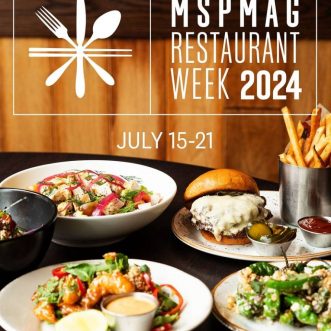EAT & DRINK: There’s nothing like eating your way through a Minnesota summer. The ballpark brats and the lakeside lobster rolls, the shore lunches and the backyard s’mores. And in the rural countryside, the lush farmland just beginning to sprout with this year’s bountiful crop of pizzas. Wait, what?
Pizza farms have always been an “if you know, you know” aspect of life in the Upper Midwest, though they might sound mystifying to anyone who hasn’t encountered one. Here in Minnesota (and Wisconsin), we take for granted that you can road-trip to a farm, spread out a blanket, order a piping hot pizza made from locally grown ingredients, and soak up every last drop of summer.
The gold standard of pizza farms, A to Z Produce and Bakery in Stockholm, Wis., announced earlier this year that after 25 years, it is retiring its legendary pizza night. Fortunately, there is a growing list of places to enjoy a farm-fresh pizza. If you’re lucky, it might be to the tune of live music — and maybe a farm animal symphony, too.
Just remember: Pack your own trash bag, picnic blanket or chairs, utensils, plates and whatever else you need for a picnic. Bug spray wouldn’t hurt, either. Clean up after yourself. Know which state you’re in (Minnesota allows you to bring your own alcoholic beverages, Wisconsin does not). And leave pets at home.
…
Here’s your summer pizza farm bucket list, from closest to Minneapolis to farthest away:
…
Red Barn
Visit horses and chickens at this 10-acre farm and wedding venue, which opens to the public for pizza night every Wednesday and the third Sunday of the month from May through October.
Address: 10063 E. 110th St., Northfield, 507-664-0304, redbarnfarmweddingsmn.com
Distance from downtown Minneapolis: 50 miles.
Prices: $23 and up for a 16-inch pizza (cash and check only).
Gluten-free/vegan options: 12-inch vegan and gluten-free cauliflower crusts available.
Beverages: Bring your own.
…
Alpha & Omega Farm
Live music accompanies Neapolitan-style brick-oven pizza made with locally sourced vegetables and organic herbs grown on the farm. Meet goats, chickens, pigs, alpacas, cows, donkeys and dogs while you wait for your pie.
Hours: May: Thursdays 4:30-8 p.m.; June: 4:30-8 p.m. Thu. and Sat.
Address: 6714 Alpha Road, Princeton, Minn., 763-234-1350, alphaomegafarm.co
Distance from downtown Minneapolis: 60 miles.
Prices: $10 advance tickets reserve you a pizza crust, which you order on-site. Pies run $21-$24 (the $10 will be deducted from your order). Semiprivate structures for large parties are available to rent.
Gluten-free/vegan options: Gluten-free crusts for $3 more.
Beverages: Bring your own alcoholic beverages. Local sodas by Whistler and bottled water for sale.
Pleasant Grove Pizza Farm
Thin, crackerlike pies with charred edges are loaded with toppings at this 55-acre farm that’s welcomed guests to pizza nights for 10 seasons.
Hours: Year-round May, Sept.-Oct.: Fri.-Sat. 4-8 p.m., Sun. 1-7 p.m.; June-Aug.: Thu.-Sat. 4-8 p.m., Sun. 1-7 p.m.; Nov.-April: Fri.-Sat. 4-8 p.m. (takeout and delivery only).
Address: 41142 160th St., Waseca, Minn., 715-523-0857, pleasantgrovepizzafarm.com
Distance from downtown Minneapolis: 63 miles.
Prices: $22 and up for a 16-inch pizza, extra toppings $2.
Gluten-free/vegan options: 10-inch gluten-free crusts and vegan cheese available.
Beverages: Bring your own.
…
Squash Blossom Farm
Near Rochester, snack on wood-fire pizza and homemade ice cream sandwiches, with live music, gardens, farm animals and yard games for entertainment. Bonus: The farm is also home to a bean-to-bar chocolate operation, a bakery specializing in sourdough breads and pastries and a mead tasting room.
Hours: Memorial Day weekend through Sept., Sun. 4-6 p.m., Thu. 6-8 p.m. starting June 13.
Address: 7499 60th Av. NW., Oronoco, Minn., 507-252-9639, squashblossomfarm.org
Distance from downtown Minneapolis: 81 miles.
Prices: $25 per pizza, preorder on the website.
Gluten-free/vegan options: Gluten-free, dairy-free and vegan accommodations available; request when ordering toppings. No extra charge.
Beverages: Mead is made at the winery and available for tastings and purchase on pizza nights.
…
The Enchanted Barn
This western Wisconsin wedding and events venue doubles as a place for stone-fired pizzas made with local ingredients (plus brick-oven smash burgers) set to live music. Watch for pop-up events throughout the summer.
Hours: Thu.-Fri. 5 p.m. (first Wednesdays of the months are burger nights).
Address: 1543 6 1/2 Av., Hillsdale, Wis., theenchantedbarn.com
Distance from downtown Minneapolis: 89 miles.
Prices: Reserve a table for $5 per person on Tock (seating can be limited); some concerts require $15-$20 tickets. Pizzas from $15.
Gluten-free/vegan options: Gluten-free crusts for $3 more.
Beverages: Alcoholic and nonalcoholic beverages available for purchase; don’t bring your own.
…
The Stone Barn
Although not a working farm, the property is memorably set within the gigantic, 121-year-old stone foundations of what had been a barn. Dog-friendly, too. Save room for dessert; there’s Chocolate Shoppe ice cream from Madison, Wis.
Hours: Fri. 5-9 p.m., Sat. noon-9 p.m., Sun. noon-8 p.m. through Oct. 1.
Address: S685 County Road KK, Nelson, Wis., 715-673-4478, thenelsonstonebarn.com
Distance from downtown Minneapolis: 91 miles.
Prices: $20-$32.
Gluten-free/vegan options: Gluten-free and keto-friendly crusts available.
Beverages: Alcoholic and nonalcoholic beverages available for purchase; don’t bring your own.
…
Suncrest Garden Farms
An idyllic 16-acre property devoted to sustainable practices offers pizza, s’mores and all-natural snow cones.
Hours: Fri. 4-8 p.m., Sat. 3-8 p.m., through Sept.
Address: S2257 Yaeger Valley Road, Cochrane, Wis., 608-626-2122, suncrestgardensfarm.com
Distance from downtown Minneapolis: 105 miles.
Prices: Cheese pizzas $13.95 for 12-inch, $20.95 for 16-inch; add meat, veggies and premium cheeses and sauces starting at $1.25.
Gluten-free/vegan options: Yes to both.
Beverages: Alcoholic and nonalcoholic beverages available for purchase; don’t bring your own.
Farm to Fork Pizza at Dancing Yarrow
Open mic night, cocktails and wood-fire pizzas (dessert pizza, too) with local ingredients at this rustic 18-acre property, complete with beekeeper and lodge. Well-behaved dogs welcome.
Hours: 5-9 p.m. Thu. (open mic) and Sat. (live music).
Address: S193 County Road BB, Mondovi, Wis., 715-926-8265, dancingyarrow.com
Distance from downtown Minneapolis: 108 miles.
Prices: $14-$22
Gluten-free/vegan options: Yes to both.
Beverages: Alcoholic and nonalcoholic beverages available for purchase; don’t bring your own.
…
DreamAcres
Enjoy vegetarian wood-fired pies made from ingredients grown on the organic farmstead, with a view of the bluffs.
Hours: Fri. 5-8 p.m. “or as far as the dough stretches,” rain or shine, May 31-Sept. 27.
Address: 17289 County Road 8, Wykoff, Minn., 507-316-3795, dreamacresfarm.org/pizza
Distance from downtown Minneapolis: 115 miles.
Prices: $20-$30
Gluten-free/vegan options: All pizzas are vegetarian; no gluten-free option.
Beverages: Bring your own.
…
Bonus burger farm: Together Farms
Take a break from pizza at this on-farm burger restaurant that uses its grass-fed and grass-finished beef and ingredients from other local producers. There’s live music, kids’ activities and a retail store featuring area suppliers.
Hours: Thu.-Fri. 4-9 p.m., Sat. noon-9 p.m., Sun. noon-7 p.m., early May through October
Address: W93 Norden Road, Mondovi, Wis., 715-210-4740, togetherfarms.com
Distance from downtown Minneapolis: 112 miles.
Prices: Burgers start at $17.50 and come with fries and a pickle. Sides, pulled pork sandwiches and desserts also are on the menu.
Gluten-free/vegan options: One fryer is dedicated gluten-free for cheese curds and Brussels sprouts; gluten-free buns and veggie patties available.
Beverages: Alcoholic and nonalcoholic beverages available for purchase; don’t bring your own.


















 Pleasant Grove Pizza Farm in Waseca, Minn., features pies with crackerlike crusts.
Pleasant Grove Pizza Farm in Waseca, Minn., features pies with crackerlike crusts.




































